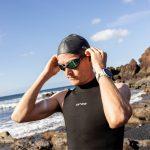River flows – and how to take advantage of them
The 2012 running of the 2.25 mile (3.6km) Hampton Court to Kingston Bridge Thames swim was held in October after several days of rain and the river was flowing fast. We estimate (very unscientifically) a current speed of around 0.6 m/s (metres per second). It made a huge difference to the finishers’ times. The winner stopped the clock around 15 minutes ahead of the previous years’ winning time and some people reported improvements of up to 50 minutes on previous attempts.
Strong currents boosted finish times at the 2012 Hampton Court to Kingston Bridge swim
But why did some people gain so much more than others? Did they read the river better and benefit more from the currents, or is something else going on?
In general, rivers flow faster in the middle than close to the banks. A kayaker racing downriver will almost always stay close to the centre line, even when going around corners where the shortest line would be to cut close to the bank. The gains from staying in the middle more than compensate for the extra distance paddled, especially as sometimes you can have eddies and back currents close to the bank.
In the Hampton event, swimmers were directed to the left bank and prevented from swimming in the middle because of other river traffic. However, there was still a choice whether to swim next to the bank or on the outermost edge of the swim course. Presumably those who chose the latter would have benefited, but it’s clearly not the full explanation of why some people gained 15 minutes and others 50.
Anecdotally, there seems to be an inverse correlation between how fast someone can swim and how much their time improved in this year’s Hampton Court swim. In fact, looking at the finishing times it can be seen that this year they’ve been compressed into a narrower range, as shown below:
| Fastest | Slowest | Range | |
| 2011 | 0:44:52 | 2:56:37 | 2:11:45 |
| 2012 | 0:30:02 | 1:13:04 | 0:43:02 |
As it’s unlikely that all slow swimmers can read the river better than all fast swimmers it’s clear that slower swimmers have, on average, benefited more from the fast flowing conditions than fast swimmers.
The reason is that they have not swum the same distance.
That’s right. Slower swimmers covered less distance than faster swimmers, but they didn’t cheat. Measured on land, all swimmers covered 2.25 miles but because they were carried some way by the water, the distance swum relative to the moving water was less for slower swimmers as they were out there for longer and hence carried further.
We can understand this more easily if we think about someone who chooses not to swim at all but to lie on their back and allow the current to take them downstream. If our estimate of the river speed is correct, it would take someone around 1hr 40m to drift the length of the course, without swimming a single stroke. In other words, the distance relative to the river would be zero.
For the swim geeks out there we can look at this mathematically as follows:
If, River speed = R, Swimmer speed = S and Distance (on land) = D then the time taken for the swim is:
T = D / (R + S) (i.e. time taken = distance divided by speed, where speed relative to the land is swim speed plus river speed)
And the effective distance (ED) swum = T x S (i.e. distance relative to the water = time taken multiplied by swim speed)
Now take two swimmers one of which averages 75s per 100m and the other 100s per 100m in still water. These are equivalent to speeds of 1.33m/s and 1.00m/s.
Time taken by swimmer 1 = 3600/(0.6+1.33) = 0:31:05
Effective distance for swimmer 1 = 0:31:05 x 1.33 = 1865 x 1.33 = 2481m
Time taken by swimmer 2 = 3600/(0.6+1.00) = 0:37:30
Effective distance for swimmer 2 = 0:37:30 x 1.00 = 2250 x 1.00 = 2250m
So swimmer 2 will swim about 230m less than swimmer 1 relative to the water, which gives a time saving of nearly 4 minutes.
If you swam at Hampton Court you can plug your own swim speed into the equations above and see how close we are and roughly how far you swam. Of course, our 0.6m/s is only a guestimate so the answers won’t be precise but we’d be interested to hear what people think.
So, slower swimmers, if you want to get closer to the people who always leave you behind in flat water, enter down-river races with strong flows. The inverse is also true though. Swimming upstream, the river speed (R) in the above equation becomes negative, which means slower swimmers will have to swim further than faster swimmers and the field will spread out more than usual.






